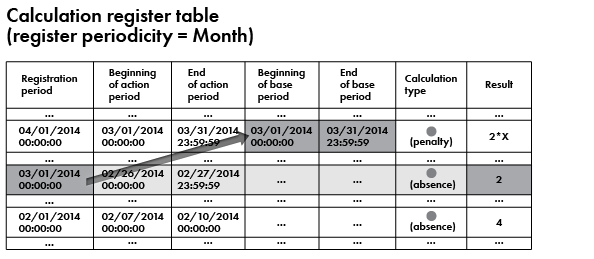Dependency by registration period means that when the platform analyzes base records, it selects the records whose Registration period field value falls within the specified base period.
Let us consider an example of penalty calculation for March salary accruals. Absence records registered in March serve as a base for calculating the penalty amounts (these can include March absence records as well as February absence records. In this scenario, as a rule, developers use dependency by registration period (fig. 17.10).

Fig. 17.10. Dependency by registration period
The final important feature of a calculation register is its connection with the chart of calculation types. This connection enables displacement by action period and dependency by base period, since a chart of calculation types describes the interrelationship between calculation types.
A calculation register can have subordinate Recalculation objects. They are used to register the fact of adding register records that affect the calculation results of existing register records. A Recalculation configuration object can have multiple dimensions, each specifying a connection between the dimensions of this calculation register and the dimensions of calculation registers that influence it. In some scenarios it can be the same register.
The platform stores the list of register records that are subject to recalculations in database tables based on Recalculation configuration objects. Recalculation tables are populated automatically based on calculation register records that are affected by leading calculation types, as well as on calculation register records that have their actual periods changed. Based on this data, a developer can decide whether the register records require recalculation.
The last observation that we need to make regarding calculation registers concerns the ability to link a calculation register to a schedule. The schedule should be represented by an information register (nonperiodic, with a mandatory dimension of Date type, and a resource of Number type), which contains time-based source data used in the calculations. The dimensions of that schedule can be, for example, a work schedule (a reference to a catalog) and a date, and its resource can store the number of working hours for that date. In this scenario you can link a calculation register record to a specific work schedule (by specifying a reference to a work schedule catalog as a record attribute) and then use 1C:Enterprise script tools to get the number of working hours in the action period, actual period, or registration period for each record.
Learn more! For details on the structure of 1C:Enterprise script objects intended for calculation register operations, see section Quick developer reference. Calculation registers.
Next page: Adding a calculation register
 Desktop version
Desktop version